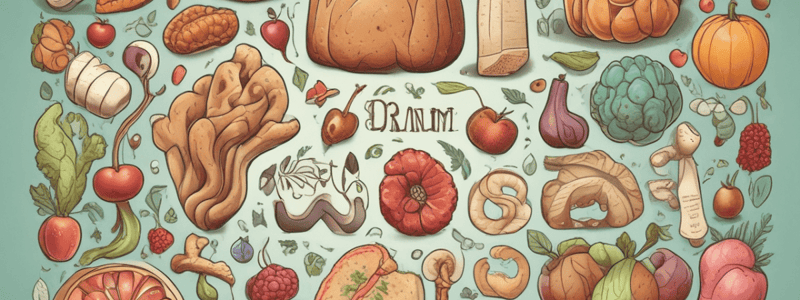Podcast
Questions and Answers
What is the fiber content of one cup of cooked split peas?
What is the fiber content of one cup of cooked split peas?
- 15.0g
- 16.3g (correct)
- 10.6g
- 11.0g
Which of the following is a rich source of soluble fiber?
Which of the following is a rich source of soluble fiber?
- Celery
- Carrots
- Oat bran (correct)
- Green peas
What is the fiber content of one ounce of peanuts?
What is the fiber content of one ounce of peanuts?
- 2.7g (correct)
- 3.0g
- 2.0g
- 3.5g
Which of the following is a rich source of insoluble fiber?
Which of the following is a rich source of insoluble fiber?
What is the fiber content of one cup of green snap beans?
What is the fiber content of one cup of green snap beans?
Which of the following has the lowest fiber content?
Which of the following has the lowest fiber content?
What is the primary function of complex carbohydrates in plants and animals?
What is the primary function of complex carbohydrates in plants and animals?
What is the main difference between starch and glycogen?
What is the main difference between starch and glycogen?
What is the energy yield of each gram of starch?
What is the energy yield of each gram of starch?
Which of the following is NOT a rich food source of starch?
Which of the following is NOT a rich food source of starch?
What is the primary site for glycogen formation and storage in the human body?
What is the primary site for glycogen formation and storage in the human body?
What happens to muscle glycogen soon after an animal dies?
What happens to muscle glycogen soon after an animal dies?
What type of starch is often included in sports drinks and energy bars?
What type of starch is often included in sports drinks and energy bars?
What is the term for the complex carbohydrates that consist of hundreds of glucose molecules?
What is the term for the complex carbohydrates that consist of hundreds of glucose molecules?
What is the primary role of fiber in the human body?
What is the primary role of fiber in the human body?
What is the difference between soluble and insoluble fiber?
What is the difference between soluble and insoluble fiber?
Which of the following foods is a rich source of insoluble fiber?
Which of the following foods is a rich source of insoluble fiber?
What happens to fiber when it is fermented by gut microbiota?
What happens to fiber when it is fermented by gut microbiota?
Why do refined grains have lower fiber content than whole grains?
Why do refined grains have lower fiber content than whole grains?
What is the benefit of soluble fiber on blood cholesterol levels?
What is the benefit of soluble fiber on blood cholesterol levels?
What is the primary difference between dietary fiber and muscle fiber?
What is the primary difference between dietary fiber and muscle fiber?
Why is it important to consume a variety of fiber-rich foods?
Why is it important to consume a variety of fiber-rich foods?
What is the benefit of insoluble fiber on bowel movements?
What is the benefit of insoluble fiber on bowel movements?
Why do whole-grain products have a higher fiber content than refined grains?
Why do whole-grain products have a higher fiber content than refined grains?
Study Notes
Complex Carbohydrates
- Complex carbohydrates (polysaccharides) are composed of monosaccharides bonded together, forming large chainlike structures.
- They are used by plants and animals to store energy or make certain structural components such as stems and leaves.
Starch and Glycogen
- Starch and glycogen are polysaccharides that contain hundreds of glucose molecules bound together.
- Plants store glucose as starch, primarily in the form of amylopectin, in their seeds, roots, and fleshy underground stems called tubers.
- Rich food sources of starch include bread and cereal products, vegetables, and tubers.
- Sports drinks and sports or energy bars often include modified starches such as maltodextrin and dextrin.
- Each gram of starch supplies 4 kcal.
- The human body stores limited amounts of glucose as glycogen, primarily in muscles and the liver.
Fiber
- Fiber is a type of complex carbohydrate that is not digestible by humans.
- There are two types of dietary fiber: soluble fiber and insoluble fiber.
- Soluble fiber dissolves or swells in water and includes pectins, gums, and beta-glucans.
- Insoluble fiber does not dissolve in water and includes cellulose and lignin.
- Rich food sources of soluble fiber include oat bran, beans, apples, carrots, and oranges.
- Rich food sources of insoluble fiber include whole-grain products, including brown rice.
- Fiber is not digested, but it may be metabolized (fermented) by gut microbiota.
- Fiber can provide important health benefits, including reducing blood cholesterol levels and easing bowel movements.
Food Sources of Fiber
- Plant foods are the only sources of dietary fiber.
- Table 5.7 lists common foods that are sources of dietary fiber.
- Examples of high-fiber foods include split peas, black beans, oat bran, kidney beans, and chickpeas.
- Whole grains, fruits, and vegetables are good sources of dietary fiber.
Key Points
- Complex carbohydrates are composed of monosaccharides bonded together.
- Starch and glycogen are types of complex carbohydrates that contain hundreds of glucose molecules bound together.
- Fiber is a type of complex carbohydrate that is not digestible by humans and provides important health benefits.
Studying That Suits You
Use AI to generate personalized quizzes and flashcards to suit your learning preferences.
Description
Understand the differences between simple sugars, polysaccharides, starch, and glycogen, and identify rich food sources of various types of fibers. Learn about the role of complex carbohydrates in energy storage and structural components.



